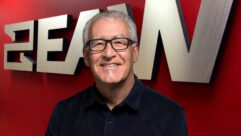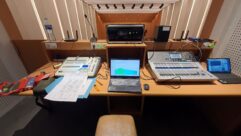Integrated for interactionThe coordination of the sound, video and live presentation systems at the Barney Theater is a perfect exampleof audio-visual teamwork.
Nov 20, 1996 12:00 PM,
Jack McLean
Sophisticated technology and a friendly purple dinosaur might seem a strange combination. Yet The Barney Theater, one of the newest attractions at Universal Studios Florida in Orlando, features this paradox to great success.
The theater hosts daily live shows featuring Barney, the preschoolers’ star of television and video. The show is the center portion of a three-part attraction, which also includes a pre-show performance and an interactive playground.
But Barney is the real attraction, rising via a lift to center stage to begin each show. Theater seating completely surrounds the stage, with more than 300 seats divided into three triangular quadrants. The show’s audio and lighting is almost totally automated.
The advanced systems for the show were put together by a combination of skilled professionals, with Signal Perfection Limited (SPL) of Columbia, MD, serving as the project’s general sound contractor. It supplied audio system design and installation, including implementation of a Peavey Electronics MediaMatrix control system, while Acoustic Dimensions of Dallas contributed its expertise in the design of the theater’s acoustics and surround-sound loudspeaker system. Soundeluxe of Orlando, FL, provided sound design and created an original soundtrack.
Itec, Orlando, assembled a comprehensive master control system that allows automatic activation and operation of audio, lighting and subsidiary systems with the push of a button. System design criteria and final design approval were the responsibilities of Tony Peugh, project manager for Universal Studios planning and development, in cooperation with Larry Howard, supervisor of show systems, and The Lyons Group, producers of Barney programming.
Automated functionsThe pre-show, held in an area immediately adjacent to the theater, features a character named Mr. Peekaboo, who entertains the crowd with a variety of tricks and jokes. He also prepares the children for Barney’s show, explaining that when the doors of the theater open, the audience should be seated as quickly as possible.
At this point, a system operator in the theater’s control booth presses a touchscreen to activate the automated facets of the show. An Otari Radar digital hard drive playback system supplies a SMPTE feed to the custom master-control system.
This custom control system comprises several components, including an Allen Bradley PLC and an Alcorn McBride V16. The control system is linked to all lighting and safety devices, reading switches and buttons and converting this information into serial command language, which is then routed. Commands to the MediaMatrix audio control mainframe are sent via RS-232, with provisions made to handle asynchronous tasks, such as paging.
Running via the SMPTE feed, automated functions are performed in a sequential line and can be monitored in the control booth. The lift bringing Barney up to center stage can only be activated at the appropriate place in the SMPTE feed by agreement among three positions: the control booth, a technician adjacent to the lift and Barney – all must push a button simultaneously.
Besides the touch panel, the control booth contains a level control that allows ±3 dB adjustment of the house audio system. Monitor loudspeakers with a rotary switch allow the operator to listen to the different portions of the audio system, including the background music, the main theater system and the interactive playground.
MediaMatrix controlThe Peavey MediaMatrix control system, housed with the power amplifiers and other components in a secured adjacent room, was selected for a variety of reasons, according to Phil DiPaula, senior design engineer for SPL. The elaborate surround-sound loudspeaker design called for fairly extensive custom equalization and required independent paging controllable via panels throughout the facility.
“Of course, we had done this with previous technologies, but Me-diaMatrix offers benefits that have not been available before,” said DiPaula. “It gives you the ability to change the system design on the fly, which we did at least twice on-site as the show developed. It also simplifies fabrication requirements considerably. Almost all wiring is done internally via computer.”The MediaMatrix mainframe comprises a hard drive and a user-defined number of DSP cards providing complete processing – delay, crossover, equalization, mixing, compressing and more – all available in a myriad of choices. Audio and control break-out boxes (BoBs), each offering eight inputs and eight outputs, can be added to accommodate even the most complex input and output requirements.
User-definable software for the DSP cards is presented in a convenient Windows format, greatly simplifying system reconfiguration. The software can be tailored to work with the hardware to build a custom system that is capable of meeting almost any need imaginable.
DiPaula emphasizes one distinct advantage presented by the integrated MediaMatrix package: elimination of the standard noise build-up that occurs when signal runs from device to device many times over. The level-matching process is greatly simplified.
Password-protected levels of security can also be established within MediaMatrix by the system designer or installer. As a result, day-to-day functions can be accessed by on-site operators, but key system parameters and settings are off limits.
“This security, along with the integrated nature of MediaMatrix, provides stability and consistency of the audio system in its daily use,” DiPaula said.
The software essentially includes three main portions, including design, troubleshooting and compile and control. Thousands of sub-options are available.
The device menu offers an extensive selection of individual processing devices that can be selected and placed on the computer screen. Once devices are placed in the desired configuration, the software’s wire mode lets the user connect all devices together via input and output nodes. Once the system is wired, it resembles an easy-to-read CAD drawing on screen. Activating the software’s compile command converts the design into an actual system, ready to receive input and supply output to the power amplifiers and loudspeakers.
A MediaMatrix functional control block proved instrumental in dealing with establishment of ducking protocol for the six paging stations in the facility. The paging stations feeding the custom control system tell MediaMatrix when to duck and then when to mix in the paging voice right over the top of the main feed. Paging can be done to one or multiple zones. With the MediaMatrix system, the ducking level’s ramp up and down can be carefully controlled, DiPaula said.
Loudspeaker objectivesThe Barney Theater loudspeaker system needed to represent accurately and enhance the complex eight-track soundtrack designed by Soundeluxe. The soundtrack includes a host of sound effects and original music that enhances the show and is used to draw audience participation.
Sound had to be localized to the staging area but with significant rejection on the stage itself. “We needed to accommodate lavalier microphone use on stage by the main character,” said Craig Janssen, principal consultant for Acoustic Dimensions. “Gain-before-feedback was a concern because of the smallness of the room combined with the system running at a fairly loud level.”Seating is divided into three main triangles, separated by ramps leading to the stage. Each seating area is its own block of approximately 60°. Covering each block without notable spillover into the ramps was another design objective.
“The stage is essentially at the center of a barrel,” Janssen said. “We didn’t want a dominant central source that would project energy into the back walls. This dictated more of a distributed approach.”An inner ring of loudspeakers was flown above the edge of the stage and fires down at the audience area. Each seating block is served by a single custom loudspeaker manufactured by EAW, which resembles its model 690 mid-high loudspeakers but with a larger-than-standard 90—40 horn, providing tighter focus and control.
Low frequencies for each block are supplied by a single EAW TD412 loaded with two 12 inch (305 mm) woofers and two 8 inch (203 mm) woofers. The TD412s are combined with proprietary signal processing for extra pattern control.
The front mid-high loudspeakers are supported by two additional modified 690s flown above the audience, almost at the midway point in each section. These loudspeakers are signal-delayed via the MediaMatrix, which also feeds two of the eight soundtrack channels to them for overhead sound effects in stereo.
Each section is covered by two JBL Control 1 loudspeakers concealed in the stage lip, and they serve to further pull the sound image down to the stage. Six EAW SSB subwoofers mounted under the stage and ramps provide sub-bass. There wasn’t much space for these loudspeakers, so the compact size of the SSBs, combined with their high output, made them ideal for this application.
Eight surround loudspeakers, JBL Control 10s, are mounted along the back wall. Four soundtrack channels are routed to these surround loudspeakers, supplying stereo sound effects as well as ambiance. For example, in portions of the show for sing-alongs, children’s voices on the soundtrack can be brought out from the surround loudspeakers to encourage the audience to sing.
Routing of all signals is done via the MediaMatrix, with each group of loudspeakers given its own signal processing. Individual parametric equalization was supplied for each loudspeaker, including the surrounds. Power is provided by a combination of Crown Com-Tech and Macro-Tech amplifiers mounted in the equipment room.
After the show, the audience is directed to a large playground area outside the theater featuring a number of interactive displays. About 18 different sound effects can be generated by pushing a button or pulling a lever.
The master control system reads the contact closures, then sound effects are generated by a Gilder Fluke solid-state repeater card. The effects are bolstered by a Rane MSA 6 multichannel power amplifier and sent to a miniature loudspeaker.
One particularly interesting display allows children to climb inside an echo tunnel. Their voices are picked up by a microphone in the tunnel, sent to a pre-amplifier and a digital reverb and then distributed back to a loudspeaker at the far end of the tunnel.
A happening placeThe Barney Theater is one of the newest attractions at Universal Studios Florida, and it’s easily one of the most popular. This can be attributed to the immense popularity of the star of the show, but the behind the scenes work of the design team can’t be overlooked as another reason for the attraction’s success.
The team’s cohesive efforts have led to the integration of technology that not only enhances the quality of the show but gets the audience – children and adults alike – actively involved with the production.
Most impressive is the consistency delivered by the systems for each and every show. With this, there’s no danger of anyone being disappointed by catching the production on an off night. When gauging the success of any project, these factors certainly must be a significant sign of a job well done.










